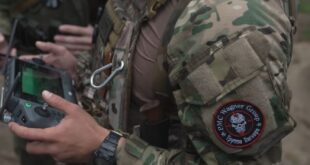Marines Set A New Record
By Harold Hutchison
From the December 2012 issue of SOF
SURPRISE FOR THE TALIBAN
On 12 February, 2012, some Taliban insurgents had no idea that death was coming for them. But come it did, in the form of a record-setting shot by United States Marines.

The shot crossed from a Marine forward operating base in Kajaki in Helmand Province to the insurgents in Musa Qala district. The shot caught the insurgents by surprise, having traveled 22 miles in its flight – the longest artillery mission in Marine Corps history.
The Taliban insurgents were all killed in the strike. It was, in a sense, the perfect engagement for the Marines—mission accomplished, bad guys out of the picture, and no Marine casualties. But the story behind this shot is impressive.
TECH MAKES THE SHOT POSSIBLE
Gunners from Golf Battery, 2/11 Marines set the record using new technology. In this case, their shot was a M982 GPS-guided artillery round known as the “Excalibur” that was fired from the M777 howitzer.
The M777 howitzer first entered service in 2005 with the U.S. Army, replacing the M198 howitzer. The M777’s biggest advantage is a longer range – as far as 25 miles, depending on the shell – compared to 18.6 for the M198. It doesn’t hurt that the M777 is about 6,750 pounds lighter than its predecessor, making it much more deployable, and that it can fire five rounds a minute compared to the M198’s four per minute.
The howitzer is also in the arsenals of Australia, India, and Canada. But the gun is only part of the equation. What made this record-setting mission possible was the round.
TURNING A 155MM HOWITZER INTO A SNIPER RIFLE
The M982 Excalibur is a GPS-guided round fired from 155mm howitzers in the American arsenal. It is not the first precision-guided round that has gained notoriety in American service. That honor belongs to the M712 Copperhead, which entered service in the 1980s as an anti-tank weapon that would be used against Soviet tanks should they come across the Fulda Gap. It saw service in Desert Storm, where 90 rounds were fired on hardened positions, and it proved to be very capable.

The Copperhead used laser guidance, which usually involves “painting” (marking) the target with a laser. This is the same system as used on the Paveway laser-guided bombs that were famously used in Desert Storm to great effect. When fired, a seeker head on the shell looked for the “marked” target and steerable fins guided the shell to hit the offending tank, building, or group of bad guys. Copperhead had a range of about ten miles, but it had some limitations. It was expensive, costing as much as $30,000 a round. Laser guidance was also much more difficult in bad weather or on a smoke-obscured battlefield. Someone needed to designate the targets, so someone has to risk their necks, and become a target.
Excalibur doesn’t help much in the price department (initial shells cost $85,000 a round), but its GPS guidance does give it all-weather capability, and it has a range of about 25 miles. That is more than twice the reach of the Copperhead. In one test by the Army, 13 out of 14 shells landed within 33 feet of the target. To put that into perspective, it means that a M777 firing from Boulder, Colorado, can reliably put its 155mm shells between the 40-yard lines of Mile High Stadium in Denver. Targeting is also easier. You just need to plug in GPS coordinates, which can be pre-surveyed.
A BAD DAY FOR THE BAD GUYS
This is bad news for bad guys. Entering combat in Iraq in 2007, just as the surge was starting, it proved itself as being able to take out insurgent safe houses while minimizing collateral damage. The major reason is that a 155mm shell contains about 20 pounds of explosives – about as much as a Hellfire missile. The smallest precision-guided bomb, the GBU-39, has 50 pounds of high explosive. Big booms may be satisfying and look cool on Youtube, but excessive collateral damage can become a recruiting tool for insurgents. Minimize the collateral damage, minimize insurgent recruitment.
 The shot on 12 February was one of as many as 30 that Marine units in Helmand Province fire in any given week, according to the Marine Corps Times. This is one other piece of bad news for the bad guys. Where once an entire battery might be needed for a mission, that same mission can now be handled by a single gun, which means other missions could be supported in a given area by the other guns of the battery.
The shot on 12 February was one of as many as 30 that Marine units in Helmand Province fire in any given week, according to the Marine Corps Times. This is one other piece of bad news for the bad guys. Where once an entire battery might be needed for a mission, that same mission can now be handled by a single gun, which means other missions could be supported in a given area by the other guns of the battery.
In a final piece of bad news for the bad guys, the Excalibur may be getting even better. Variants with dual-purpose improved conventional munitions (DPICM) or sense-and-destroy armor (SADARM) are in development, and there are plans for next-generation smart munitions as well. The Excalibur of legend was the sword King Arthur used to strike down England’s enemies. The GPS-guided Excalibur artillery round is proving that it is very capable of doing the same to America’s enemies.
As for the Marines of Golf Battery? They have returned to the United States after their deployment.
 Soldier of Fortune Magazine The Journal of Professional Adventurers
Soldier of Fortune Magazine The Journal of Professional Adventurers





